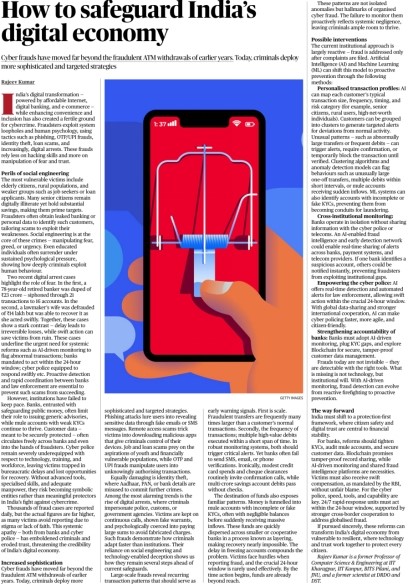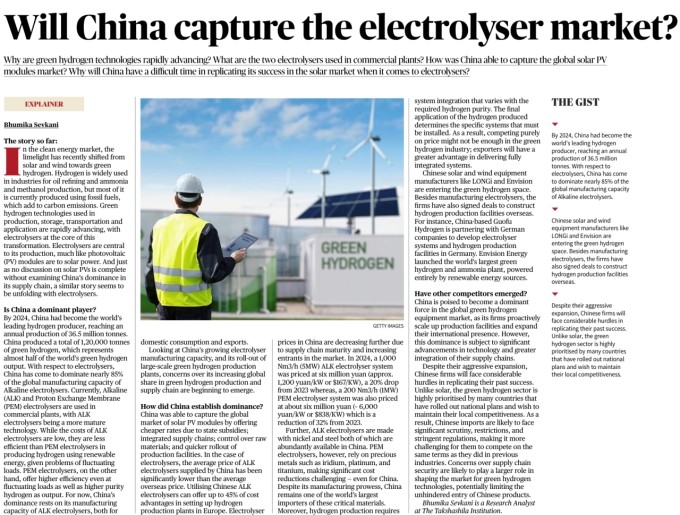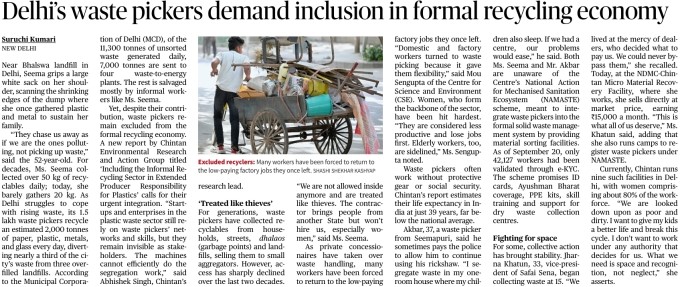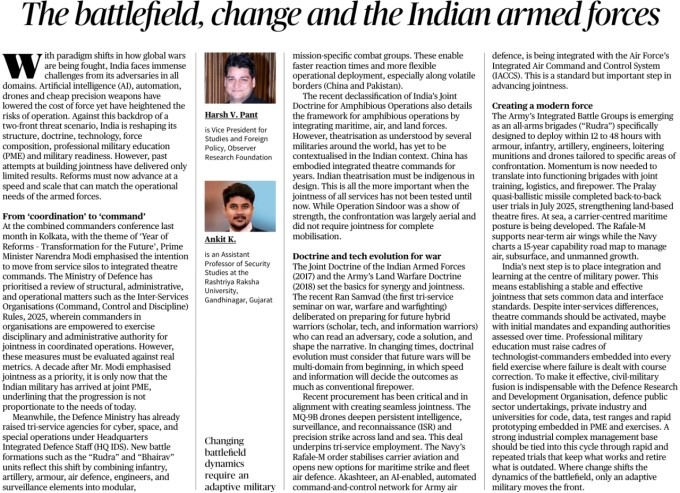Syllabus Mapping: GS Paper 3: Various Security forces and agencies and their mandate; Challenges to internal security through communication networks
Context
- Global warfare is undergoing a paradigm shift due to Artificial Intelligence (AI), automation, drones, precision weapons, and multi-domain threats.
- India, facing unique challenges from its adversaries, particularly in a two-front war scenario (China & Pakistan), must adapt swiftly.
- The Government of India has launched reforms to move from service-specific structures to integrated theatre commands to strengthen jointness, interoperability, and readiness.
- The Year of Reforms: Transformation for the Future initiative highlights this transition.
What is it all about? - India is attempting to transform its armed forces from coordination between services to command through integrated theatre commands.
- Reforms include restructuring, doctrinal innovation, technological adoption, professional military education (PME), and modernisation of forces.
- The aim is to build a modern, joint, tech-enabled military that can respond quickly and effectively in multi-domain hybrid wars.
Detailed Analysis 1. From Coordination to Command - The Ministry of Defence is shifting from service silos to integrated theatre commands for joint operations.
- Reforms include:
- Inter-Services Organisations (Command, Control and Discipline) Rules, 2025: gives commanders greater disciplinary and administrative powers.
- Enhanced role of Headquarters Integrated Defence Staff (HQ IDS) for cyber, space, and special operations.
- Formation of Rudra and Bhairav battle formations to integrate various arms (air defence, engineers, artillery).
2. Doctrine and Technological Evolution - Doctrinal Reforms:
- Joint Doctrine of Indian Armed Forces (2017) and Army’s Land Warfare Doctrine (2018) stress synergy and jointness.
- Ran Samvad seminar emphasised hybrid warriors (scholar-tech-warriors) who can anticipate adversaries and adapt dynamically.
- Technological Reforms:
- Use of AI, drones, ISR (Intelligence, Surveillance, Reconnaissance), and precision strike systems.
- Procurement of MQ-9B drones for persistent surveillance.
- Navy’s Rafale-M fighter jets and carrier-based platforms to boost maritime strength.
- Akashteer AI system for air defence integration.
- Integration of Air Force’s IACCS (Air Command and Control System) for unified operations.
3. Creating a Modern Force - Integrated Battle Groups (IBGs): e.g., Rudra, designed to deploy within 12–48 hours with all-arms capability (infantry, artillery, engineers, drones).
- Pralay missile system: land-based, quasi-ballistic missile to strengthen deterrence.
- Naval modernisation: carrier-based Rafale-Ms, unmanned underwater and aerial vehicles, and 15-year capability roadmaps.
- Focus on joint training, logistics, firepower, and PME.
4. Challenges in Building Jointness - Resistance from entrenched service silos.
- Lack of standardised command systems and communication protocols.
- Professional Military Education (PME) still limited in preparing officers for multi-domain warfare.
- Need for civil-military fusion in defence R&D, involving DRDO, private industry, and academia.
5. Way Forward - Move beyond rhetoric of jointness to operational joint theatre commands.
- Establish common data standards and interface systems across Army, Navy, and Air Force.
- Invest in PME 2.0 for training technologist-commanders.
- Expand civil-military integration for faster tech adoption (AI, drones, hypersonics, cyber).
- Adopt a third industrial complex management base—continuous prototyping, rapid fielding, discarding obsolete systems.
- Ensure reforms are contextualised to Indian needs, not merely copied from foreign models.
UPSC Mains
"Discuss the significance of India’s shift from coordination to command through integrated theatre commands in the context of emerging multi-domain hybrid wars."
How to safeguard India’s digital economy.

Syllabus Mapping: GS Paper 3: Challenges to internal security through communication networks, basics of cyber security; money-laundering and its prevention
Context
- India’s rapid digital transformation—driven by affordable internet, digital banking, UPI, and e-commerce—has enhanced convenience and inclusion.
- However, it has simultaneously created fertile ground for cyber frauds.
- The nature of fraud has evolved: from ATM skimming and phishing to targeted scams exploiting human psychology (fear and trust).
- Recent incidents show both the speed at which frauds occur and the cost of institutional delay in detection and action.
- Protecting India’s digital economy is crucial for financial stability, consumer trust, and national security.
What is it all about? - Fraudsters exploit system loopholes and social engineering tactics like:
- Phishing
- OTP/UPI frauds
- Identity theft
- Loan scams
- Digital asset theft
- Victims: elderly, rural users, job seekers, loan applicants, and even educated individuals under psychological pressure.
- The core techniques involve manipulation of fear, urgency, and trust rather than advanced hacking.
- Banks and institutions remain underprepared with weak KYC enforcement, poor coordination, and delayed response times.
Detailed Analysis 1. Perils of Social Engineering - Victims are lured through fake emails, SMS, or malicious links.
- Fraudsters exploit personal data, leaked bank info, or incomplete KYC accounts.
- Even financially literate individuals fall prey under fear-driven manipulation.
2. Institutional Shortcomings - Banks issue generic advisories instead of real-time action.
- Customer data is poorly secured and often shared widely.
- Inadequate cyber police manpower and lack of coordination with telecom providers.
- Current system is reactive—fraud addressed only after complaints are filed.
3. Possible Interventions a. AI & ML for Prevention - Personalised transaction profiles: AI can flag unusual patterns like large one-time transfers, multiple debits in short intervals, or sudden inflows.
- Clustering algorithms can group customers (e.g., senior citizens, rural users) for targeted risk alerts.
b. Cross-institutional monitoring - AI-enabled fraud intelligence networks can share real-time alerts across banks, payment systems, and telecom operators.
c. Empowering Cyber Police - Automated AI alerts for law enforcement within the critical 24-hour window.
- Stronger international data-sharing for faster, citizen-friendly cyber policing.
d. Strengthening Accountability of Banks - Mandatory AI-driven monitoring, KYC upgrades, and Blockchain adoption for tamper-proof fraud data.
- Banks must act within 24 hours to prevent losses.
e. Government Initiatives and Measures - Indian Cyber Crime Coordination Centre (I4C): Launched in 2018, it coordinates responses and runs the NCRP for reporting incidents.
- Cyber Swachhta Kendra: For malware detection and botnet cleaning.
- Data Protection Laws: The Digital Personal Data Protection Act, 2023, mandates data security, with penalties up to ₹250 crore for breaches.
- AI-Driven Measures: As per PIB (2025), the government is focusing on AI to curb financial losses, including training programs for police.
- Recent Actions: In 2025, RBI guidelines require banks to reimburse fraud losses within 10 days if negligence is not on the customer's side. However, implementation remains uneven, with calls for a dedicated Cyber Fraud Mitigation Centre.
4. Way Forward - India needs a protection-first framework, not just awareness campaigns.
- Reforms required:
- Stricter KYC and AI-driven fraud detection.
- Blockchain for secure transaction data.
- Real-time fraud coordination between banks, telecoms, and cyber police.
- Victim protection mechanisms where RBI ensures reimbursement.
- Citizen safety and trust in digital transactions must become central to digital economy policies.
UPSC Mains "India’s rapid digitalisation has enhanced financial inclusion but also made the economy vulnerable to cyber frauds. Discuss the institutional, technological, and policy measures required to safeguard India’s digital economy."
Will China capture the electrolyser market?

Syllabus mapping: GS Paper 3: Infrastructure: Energy, Ports, Roads, Airports, Railways etc.; Conservation, environmental pollution and degradation, environmental impact assessment
Context
- The global clean energy transition is moving beyond solar and wind to green hydrogen, which is seen as a critical fuel for decarbonisation.
- Hydrogen is widely used in oil refining, ammonia, and methanol production, but most of it is produced using fossil fuels, contributing to carbon emissions.
- Green hydrogen technologies—production, storage, transportation, and application—are rapidly advancing, with electrolysers at the core of production.
- Much like China’s dominance in solar photovoltaic (PV) modules, questions are being raised about whether it can replicate similar success in the electrolyser market.
What is it all about? - Electrolysers split water into hydrogen and oxygen using electricity; when powered by renewables, the hydrogen produced is termed green hydrogen.
- Two main electrolyser technologies:
- Alkaline Electrolysers (ALK): Mature, cheaper, but less efficient.
- Proton Exchange Membrane (PEM) Electrolysers: More efficient, better for renewable integration, but expensive.
- China has already become a global leader in hydrogen production and dominates alkaline electrolyser manufacturing capacity (≈85% of global supply).
- However, challenges exist in replicating solar PV-type success in this new market.
Detailed Analysis 1. China’s Position in Green Hydrogen - By 2024: China became the world’s largest hydrogen producer, with annual production of 36.5 million tonnes (≈ half of global output).
- Installed electrolyser capacity of 70,000 tonnes of green hydrogen/year.
- Controls 85% of global alkaline electrolyser manufacturing.
- Major players: LONGi, Envision Energy, among others, expanding rapidly into the hydrogen domain.
2. How Did China Capture Solar PV Modules? - Strong state-led policies and subsidies.
- Large-scale domestic demand.
- Aggressive manufacturing scale-up.
- Supply chain dominance through low costs and global exports.
3. Challenges for China in Electrolyser Market Unlike solar PV, hydrogen is not just about cost competitiveness: - Technology Dependence:
- Green hydrogen requires integrated, high-purity, customised electrolyser systems.
- Exporters with proven track records may have an edge over China’s mass-producers.
- System Integration Requirements:
- End-users demand fully integrated hydrogen systems with transport, storage, and usage pathways.
- This makes quality and reliability more critical than just low price.
- Regulatory & Market Constraints:
- Green hydrogen projects depend heavily on national decarbonisation policies.
- Many countries prioritise domestic manufacturing and self-reliance, unlike the global openness that favoured China in solar PV.
- Competition & Technology Leaders:
- Europe (Germany, UK) and US firms are pushing advanced PEM electrolysers and system integration models.
- For instance, Envision is partnering with German firms for large-scale hydrogen facilities.
4. Emerging Global Competition - European and US companies are leveraging technological superiority (PEM, SOEC – Solid Oxide Electrolysis Cells).
- China faces hurdles in foreign policy trust deficits and restricted access in Western markets.
- Unlike solar, where price dominance worked, hydrogen markets need quality, integration, and reliability.
5. Way Forward - China will remain a key player due to scale and cost advantage, but its dominance will be less absolute compared to solar PV.
- To succeed globally, it must:
- Invest in advanced electrolyser technologies (PEM, SOEC).
- Enhance system integration capabilities.
- Build international partnerships for hydrogen infrastructure.
- For India:
- Opportunity to build domestic electrolyser manufacturing under the National Green Hydrogen Mission.
- Collaborations with EU, US, and Japan can reduce reliance on Chinese imports.
- Leveraging PLI schemes and R&D in PEM/SOEC is critical.
UPSC Prelims Q. With reference to
green hydrogen production technologies, consider the following statements:
1. Alkaline electrolysers are less efficient than Proton Exchange Membrane (PEM) electrolysers but are cheaper and widely used in commercial plants.
2. PEM electrolysers are better suited for renewable energy integration due to their flexibility and efficiency.
3. By 2024, China accounted for more than 80% of the global manufacturing capacity of alkaline electrolysers.
Which of the statements given above is/are correct?
(a) 1 only
(b) 1 and 2 only
(c) 2 and 3 only
(d) 1, 2 and 3
Answer: (d) 1, 2 and 3
ANRF’s SARAL to simplify scientific research papers
GS Paper 3: Science and Technology - developments and their applications and effects in everyday life; Achievements of Indians in science & technology; indigenization of technology and developing new technology
Context
- The Anusandhan National Research Foundation (ANRF), India’s newest science funding agency, has launched a tool called SARAL (Simplified and Automated Research Amplification and Learning).
- Aim: To make scientific research more accessible to the general public by generating layperson summaries of complex research papers.
- This initiative reflects India’s push to strengthen science communication, research accessibility, and public engagement in R&D.
What is it all about? - SARAL Tool:
- Uses Artificial Intelligence (AI) to extract information from scientific publications.
- Converts complex research into videos, podcasts, posters, and presentations for wider dissemination.
- Purpose: To bridge the gap between scientific community and society, ensuring research outcomes are understood by non-experts.
- Focus Areas: “Deep science and engineering” with applications in drug discovery, aerospace, climate and weather studies, and advanced materials design.
Detailed Analysis 1. ANRF and its Mandate
- Established as a single-window clearance system for funding research and development.
- Replaces and absorbs functions of the erstwhile Science and Engineering Research Board (SERB).
- To receive ~70% of its funding from private sources while also channeling government support.
- Governing council expected to evaluate priority sectors for funding.
2. SARAL: Role and Significance - Tackles the problem of technical jargon in research papers that limits public understanding.
- Promotes science literacy and makes outcomes more inclusive and transparent.
- Helps policymakers, students, industry, and civil society access and apply research outcomes.
- Facilitates translation of complex R&D into usable knowledge for industries and startups.
3. Supporting Schemes and Funding - Union Cabinet (July 2024) approved a ₹1 lakh crore Research Development and Innovation Scheme.
- Provides low-interest, long-tenure loans to private companies for R&D.
- ANRF aligns with national strategies to boost core science, engineering, and startup ecosystems.
4. Broader Implications - For Academia: Simplifies research dissemination, encourages collaboration, and enhances impact.
- For Industry & Startups: Accelerates technology transfer, supports “deep tech” innovation.
- For Governance & Society: Strengthens informed policymaking, public trust in science, and citizen participation in technology debates.
- For India’s R&D Ecosystem: Positions India as a leader in AI-driven science communication tools, bridging the research-to-application gap.
Way Forward - Promote AI integration across other government science initiatives.
- Build collaborations with universities, media, and civil society for outreach.
- Ensure inclusivity by publishing summaries in regional languages.
- Align ANRF’s mission with India’s National Education Policy (NEP) 2020, Start-up India, and Deep Tech Mission.
UPSC Prelims Q. With reference to the Anusandhan National Research Foundation (ANRF), consider the following statements:
1. It has launched SARAL, an AI-based tool to simplify scientific research for wider accessibility.
2. It is mandated to provide research funding only to government institutions and excludes private institutions.
3. It has absorbed most of the functions of the erstwhile Science and Engineering Research Board (SERB). Which of the statements given above is/are correct?
(a) 1 and 2 only
(b) 2 and 3 only
(c) 1 and 3 only
(d) 1, 2 and 3
Answer: (c) 1 and 3 only
PLI scheme for textile sector likely to be revised
Syllabus mapping: GS Paper 3: Indian Economy and issues relating to planning, mobilization of resources, growth, development and employment; Inclusive growth and issues arising from it
Context
- The Government of India introduced the Production Linked Incentive (PLI) Scheme to boost domestic manufacturing, reduce import dependence, and enhance global competitiveness.
- In the textile sector, the scheme focuses on Man-Made Fibre (MMF) and Technical Textiles to modernize production and expand exports.
- The Ministry of Textiles is now working on a revised version of the PLI scheme to make it more flexible, industry-friendly, and MSME-inclusive.
What is it all about? - The revised scheme aims to expand opportunities, ensure ease of doing business, and attract greater investments, particularly in MMF textiles.
- Key expected changes include:
- Addition of new HSN codes: 8 for MMF apparel and 9 for MMF fabrics.
- Lowered investment thresholds:
- ₹150 crore (Part IA)
- ₹50 crore (Part 2A)
- Incremental turnover required for incentives set at 10%.
- The new framework allows existing firms to participate by setting up new units under the revised criteria.
Detailed Analysis 1. Need for Revision - Original scheme faced challenges due to high investment thresholds, limiting participation to large firms.
- Small and medium enterprises (SMEs) and startups found it difficult to qualify.
- Industry stakeholders demanded a more inclusive structure to attract wider participation and faster adoption.
2. Features of Revised Scheme - Flexibility & Ease of Doing Business: Designed to align with business realities of textile units.
- Support for MSMEs: Lower investment barriers ensure broader industry participation.
- Focus on Growth Sectors: MMF & Technical Textiles targeted, as they have high potential in global markets.
- Turnover-linked incentives: Encourages productivity and competitiveness while reducing speculative investments.
3. Expected Benefits - Boost to MMF Production: Helps India reduce dependence on cotton-based textiles and align with global demand for synthetic fibres.
- Exports & Global Competitiveness: Enhances India’s positioning in technical textiles and man-made fabrics, where competitors like China and Vietnam are strong.
- MSME Growth: Revised structure will attract investments from smaller players, increasing innovation and employment.
- Fast-tracked Implementation: Lowering thresholds makes scheme more practical, ensuring faster results in capacity building.
4. Concerns & Way Forward - Monitoring & Compliance: Ensuring transparency in turnover-based incentives.
- Global Trade Competition: India must enhance quality standards to compete with established exporters.
- Sustainability Challenge: As MMF is petrochemical-based, India must invest in green and sustainable fibres.
- Long-term Policy Support: Consistency in PLI schemes and alignment with National Technical Textiles Mission is crucial.
UPSC Prelims Q. With reference to the PLI Scheme for Textiles, consider the following statements:
1. The scheme focuses primarily on boosting production of man-made fibre (MMF) and technical textiles.
2. The revised scheme proposes to include new HSN codes for both MMF apparel and fabrics.
3. The minimum investment threshold under the revised scheme has been set at ₹500 crore for all categories of units. Which of the statements given above is/are correct?
(a) 1 and 2 only
(b) 2 and 3 only
(c) 1 and 3 only
(d) 1, 2 and 3
Answer: (a) 1 and 2 only
Delhi’s waste pickers demand inclusion in formal recycling economy
Syllabus mapping: GS Paper 3: Economy - Inclusive growth and issues arising from it; Conservation, environmental pollution and degradation
Context
- India’s cities are struggling with rising waste volumes, and informal waste pickers play a crucial role in recycling and waste diversion.
- In Delhi alone, 1.5 lakh waste pickers recycle ~2,000 tonnes of waste daily, diverting nearly one-third of the city’s waste from landfills.
- Yet, despite their contribution, they remain excluded from the formal recycling economy, lacking recognition, social security, and workplace protections.
- A report by Chintan Environmental Research and Action Group highlights the urgent need to integrate waste pickers into formal systems like the Extended Producer Responsibility (EPR) framework.
What is it all about? - Waste pickers collect and segregate plastics, paper, glass, and metals from households, streets, and landfills, selling them to aggregators.
- They form the backbone of recycling, but remain invisible stakeholders—treated as outsiders, denied access to waste sites, and forced into insecure jobs.
- Many workers, particularly women and elderly, face the brunt of job losses as private contractors and machines replace manual segregation.
Detailed Analysis 1. Challenges Faced by Waste Pickers - Exclusion from Formal Economy: Despite their contribution, waste pickers are not integrated into municipal solid waste systems.
- Precarious Work Conditions:
- No protective gear, health coverage, or legal recognition.
- Life expectancy of waste pickers in Delhi is estimated at just 39 years (well below national average).
- Gendered Impact: Women, who form 80% of the workforce in some facilities, are often the first to lose jobs and are considered less productive.
- Economic Vulnerability: Dependent on contractors and dealers who decide prices; many forced back into low-paying factory jobs.
2. Formalisation Efforts - NAMASTE Scheme (National Action for Mechanised Sanitation Ecosystem):
- Aims to integrate waste pickers into formal solid waste management.
- Promises ID cards, PPE kits, skill training, health coverage under Ayushman Bharat, and sorting facilities.
- As of September 2024, ~42,127 workers validated through e-KYC.
- Chintan’s Micro Material Recovery Facilities:
- Women-led initiatives where waste pickers sell directly at market prices.
- Provide stability, recognition, and better incomes (~₹15,000/month).
3. Significance of Inclusion - Environmental Benefits: Informal workers help divert large quantities of waste from landfills and incinerators.
- Economic Benefits: Lower costs of recycling, support for circular economy, and contribution to Extended Producer Responsibility (EPR).
- Social Justice: Recognition of waste pickers ensures dignity of labour, improved working conditions, and poverty alleviation.
- Policy Alignment: Supports goals of Swachh Bharat Mission 2.0, Circular Economy Framework, and SDG 12 (Responsible Consumption and Production).
4. Way Forward - Recognise waste pickers as formal workers under municipal solid waste management systems.
- Expand NAMASTE and similar initiatives to all urban local bodies.
- Provide social security nets—healthcare, pensions, protective equipment, and education for children.
- Promote waste picker cooperatives and women-led collectives for direct market participation.
- Strengthen Extended Producer Responsibility (EPR) to mandate inclusion of informal sector in plastic and packaging waste management.
UPSC Prelims Q. With reference to waste pickers in India, consider the following statements: 1. Waste pickers contribute significantly to recycling, yet most remain excluded from formal solid waste management systems. 2. The NAMASTE scheme aims to integrate waste pickers into the formal economy by providing ID cards, PPE kits, and health coverage. 3. According to recent estimates, the life expectancy of waste pickers in Delhi is higher than the national average. Which of the statements given above is/are correct?
(a) 1 only
(b) 1 and 2 only
(c) 2 and 3 only
(d) 1, 2 and 3
Answer: (b) 1 and 2 only
DigiLocker
Syllabus:
GS Paper 2 – Governance; Topic: E-Governance and Digital Initiatives Context:
The
UPSC will now verify candidates’ caste, income, and disability certificates through
DigiLocker to curb forged submissions. As part of its centenary celebrations, UPSC has also launched the
“My UPSC Interview” portal for sharing interview anecdotes.
Key Points: About DigiLocker 1.
Initiative: A flagship project under
Digital India, offering a secure cloud-based platform for storing and sharing digital documents.
2.
Ministry: Developed by the
Ministry of Electronics and Information Technology (MeitY).
3.
Aim: Promotes
digital empowerment,
paperless governance, and
faster service delivery.
4.
Digital Wallet: Stores documents like
Aadhaar, PAN, DL, caste and educational certificates in digital form.
5.
Legal Status: Documents are
legally equivalent to originals under
Rule 9A of IT Rules, 2016.
6.
Verification: Enables
real-time verification directly from issuing authorities, reducing fraud and delays.
7.
Governance: Supports
eco-friendly, efficient record-keeping by cutting administrative burden.
About “My UPSC Interview” Portal 1.
Launch: A centenary initiative of
UPSC.
2.
Purpose: Invites serving and retired civil servants to share their
interview experiences.
3.
Outcome: Builds a
repository of anecdotes for aspirants, enhances
transparency, and preserves
institutional memory.
4.
Publication: Selected entries to be compiled and released in
2026 as part of centenary celebrations.
Source: New Indian Express
India Re-elected to Part II of ICAO Council
Syllabus: GS Paper 2 – International Relations; Topic: International Organisations & Global Governance Context:
India was re-elected to Part II of the ICAO Council on 27 September 2025 during the 42nd ICAO Assembly in Montreal, reflecting growing trust from member states and India’s increasing influence in global civil aviation.
Key Points:
1. About ICAO: A UN specialised agency that governs international civil aviation, with 193 member states.
2.
Council Composition: ICAO Assembly elects a
36-member Council, Part II including states contributing to
international air navigation facilities.
3.
India’s Membership: Founding member since
1944, serving continuously for
81 years.
4.
Election Campaign: Ministry of Civil Aviation hosted
ambassadorial receptions and MEA strengthened diplomatic outreach to secure votes.
5.
Diplomatic Efforts: Minister Shri
Rammohan Naidu held bilateral meetings and India’s ICAO Representative actively canvassed member states.
6.
India’s Aviation Role: Fast-growing aviation market, with
aircraft manufacturing, MRO services, and skill development, contributing to ICAO’s global mission.
7.
2025–2028 Commitments:
o Enhance
aviation safety and security globally.
o Promote
sustainable and equitable air connectivity.
o Support
technological innovation in aviation.
o Back
No Country Left Behind initiative for developing states.
8.
Significance: Demonstrates India’s
leadership in civil aviation, ensures its
voice in global policy-making, and strengthens
international aviation governance.
Source: Indian Express
Syllabus: GS Paper 3 – Agriculture;
Topic: Agricultural Development and Food Security Context:
The Union Cabinet approved the National Pulses Mission (2025–31) with a budget of ₹11,440 crore to increase domestic pulse production, ensure food and nutritional security, and reduce import dependency.
Key Points:
1. Duration: Six-year programme from 2025–26 to 2030–31 under Ministry of Agriculture & Farmers’ Welfare.
2.
Aim: Raise domestic pulse production from
242 lakh tonnes (2024–25) to
350 lakh tonnes by 2030–31.
3.
Budget: Allocated
₹11,440 crore for implementation.
4.
Production Expansion: Increase area to
310 lakh hectares with yield target of
1,130 kg/ha.
5.
Seed Security: Distribute
126 lakh quintals of certified seeds and
88 lakh free seed kits via
SATHI portal.
6.
Assured Procurement: 100% MSP procurement for
Tur, Urad, and Masoor for four years.
7.
Infrastructure Support: Set up
1,000 post-harvest processing units with subsidy up to
₹25 lakh each.
8.
Research & Innovation: Conduct
multi-location trials for climate-resilient and pest-resistant pulse varieties.
9.
Farmer Training: Implement
capacity-building programmes for modern farming techniques.
10.
Significance: Ensures
food & nutritional security, reduces
15–20% import dependency, and provides
MSP-based income stability for farmers.
Source: PIB
Philippines
Syllabus: GS Paper 1 – Geography; Topic: World Geography – Countries and Features Context:
A strong
6.9 magnitude offshore earthquake recently struck Cebu province in central Philippines, highlighting the region’s geological vulnerability as part of the Pacific “Ring of Fire.”
Key Points: 1.
Location: An
island nation in Southeast Asia situated in the western Pacific Ocean.
2.
Borders: Shares
maritime boundaries with Vietnam (west), Taiwan (north), Palau (east), Malaysia & Indonesia (south).
3.
Surrounding Seas: Bounded by
South China Sea (north & west),
Philippine Sea (east),
Celebes Sea (south), and
Sulu Sea (southwest).
4.
Highest Point: Mount Apo (Mindanao).
5.
Major Rivers: Includes
Cagayan River (longest), Mindanao River, and Agusan River.
6.
Volcano: Mayon Volcano is among the most active in the world.
7.
Climate: Predominantly
tropical and monsoonal.
8.
Major Lake: Laguna de Bay (largest freshwater lake).
9.
Natural Resources: Rich in
timber, petroleum, nickel, cobalt, silver, gold, salt, and copper.
10.
Energy: Third-largest producer of geothermal energy globally (after USA & Indonesia).
11.
World Heritage Site: Puerto-Princesa Subterranean River National Park, listed in
1999.
12.
Capital: Manila.
Source: Indian Express
Payments Regulatory Board
Syllabus: GS Paper 3 – Indian Economy; Topic: Monetary Policy & Payment Systems Context:
The RBI has constituted a new
six-member Payments Regulatory Board (PRB) to provide dedicated regulatory and supervisory oversight of India’s payment systems, ensuring safe and efficient transactions.
Key Points:
1. Legal Basis: PRB derives powers from the Payment and Settlement Systems Act, 2007.
2.
Replacement: It replaces the earlier
Board for Regulation and Supervision of Payment and Settlement Systems (BPSS).
3.
Composition: The PRB consists of
six members in total.
4.
Chairperson: The
RBI Governor serves as the
ex officio Chairperson.
5.
Ex-officio Members: Includes the
Deputy Governor and the
Executive Director handling Payment & Settlement Systems.
6.
Government Nominees: The
Central Government nominates three members to the PRB.
7.
Permanent Invitee: The
Principal Legal Adviser of RBI attends meetings as a permanent invitee.
8.
Support: The
Department of Payment and Settlement Systems (DPSS) will function directly under the PRB.
9.
Decision-Making: Decisions are by
majority vote; in case of a tie, the
Chairperson (or Deputy Governor) has a casting vote.
10.
Meetings: The PRB must meet at least
twice every year.
11.
Functions: Responsible for
regulation and supervision of all payment systems — electronic, non-electronic, domestic, and cross-border.
Source: Indian Express








